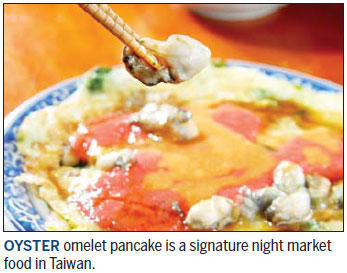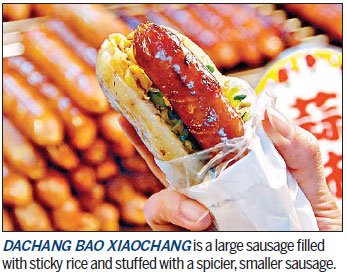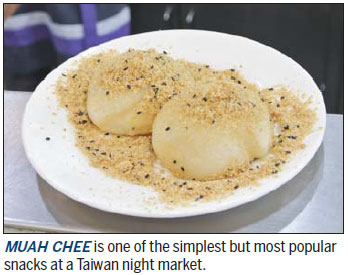Where gourmets forage at night

Editor's note: To understand China, sit down to eat. Food is the indestructible bond that holds the whole social fabric together and it is also one of the last strong visages of community and culture.
It all comes alive after dark. Taiwan's night markets are famous the world over as delicious haunts for local gourmets and curious foreign visitors. This is where you can feast your eyes and satisfy your stomach.
Before they became tourist attractions, the night markets started out as groups of itinerant stalls clustered around major temples.
| Taiwan night market snacks are adapted from regions all over China, from neighboring Fujian province, from the Jiangsu-Zhejiang area, and even as far away as Sichuan. Photos Provided to China Daily |
Both Taiwan's indigenous peoples and its later immigrants are extremely religious, or some may say, deeply superstitious. Praying at temples or baibai is very much part of daily life - before important decisions are made, prior to taking long journeys or examinations, and at births, deaths, weddings and anniversaries. Once they have delivered their spiritual difficulties into the hands of the gods, the devout can leave the temples in search of more immediate earthly gratification.
In Chinese, easing that empty tummy is also known as "praying to the temple of five internal organs", so you can see how seriously we take our food.
Night market food is food for the masses, so it tends to be cheap, tasty and mobile. A lot of local ingredients are used, spiced up with ingenious innovations that have become a uniquely Taiwan trademark.

These snacks are adapted from regions all over China - from neighboring Fujian province, from the Jiangsu-Zhejiang area, and even as far away as Sichuan, where a lot of the old war veterans came from. Taiwan beef noodles definitely hail from Sichuan.
Another major influence was Japan, a country which occupied the island for a period of time and influenced both its architecture and food.
So, at Taiwan's many night markets, you can see a confluence of culinary influences.
Take the famous oyster omelet pancake, the oh-wah-jian. It uses a batter of sweet potato starch at the base, with generous handfuls of shucked oysters scattered on top before a few eggs are broken up and mixed in.
So far, it's pretty similar to the Fujian or Shantou versions you get on the mainland. But, wait. The Taiwan cook next adds handfuls of shredded lettuce, folds over the pancake and then slathers a lurid pink sweet and sour sauce over the whole.
And, no Taiwan resident would have it otherwise.
Oysters appear again in another popular dinner choice - thick bowls of wheat starch noodles called oh-wah-mee-sua. Its sliminess makes it an acquired taste.
Another distinctive snack is stinky tofu, which originated from the Anhui-Jiangzhe lake and river districts. The slightly fermented tofu cubes are just as pungent, but in Taiwan they are deep-fried to a crispy crust, served with hot sauce and a pile of sweet and sour pickled cabbages. It's a thoughtful improvement to just plain, old stinky tofu.
Like most southern Chinese, the Taiwan food-hunter loves fried foods and nothing is more representative than the huge chicken chops that are hammered paper thin, breaded and deep-fried to a size that can cover your whole face. At the same stall, you can also buy sweet potato balls that are like corn puffs but flavored with a powdered pickled plum. That combination of crisp and oily, salty and sweet, and also sour can be oddly addictive.
In fact, chicken chop franchises have gone international.

My favorite is an old classic - peppered buns baked on the sides of a hot oven very much like a tandoor. It's really just a bun filled with spicy meat flavored with tons of chopped scallions and copious amounts of black pepper, hence the name.
Taiwan snacks also draw from the West, like the sausages you see being grilled at every night market. Here, the similarities end because the flavorings are all Chinese, with sugar, garlic and five-spice powder being the main seasonings.
Take the dachang bao xiaochang, for instance, which is a large sausage filled with sticky rice, split open and stuffed with a spicier, smaller sausage. Just looking at them grilling the links is enough to make your mouth water.
There are also Taiwan takes on sweet and savory choux pastries, Japanese mochi, and meatballs.
It is an art eating a sticky large Taiwan-style meatball, or bak wan. First, it is huge and easily fills a rice bowl. You're given a spoon to cut it open and expected to first slurp up the thin, translucent wrapper made of teeth-clinging sweet potato starch.
Once you have dealt with the wrapper, you can pour soup onto the filling and slurp that up as well.
Of course, there are also myriad stalls offering grilled meat and vegetable skewers of every description, but you have to look out for the octopus tentacles, which are smoky and succulent and delicious to chew on as you reflectively wander down the lane looking for the next treat.
If you are feeling a bit parched after all those fried and grilled foods, it's time to stop for a platter of shaved ice, preferably mango flavored.
A lighter, perhaps more palatable, alternative is aiyubing, which is jelly made from processed green fig sap. It is usually served on lots of shaved ice and flavored with local limes.

paulined@chinadaily.com.cn
Must-try snacks at Taiwan's night markets
Ice cream spring rolls
Scoops of ice cream are placed on a spring roll wrapper and topped with crushed peanut brittle and chopped coriander. It sounds absolutely weird, but this cold and sweet spring roll is oddly delicious.
Salted egg yolk lava cakes
Whoever invented this probably never heard of cholesterol. A chilled custard using mashed, salted egg yolks is buried in a dough ball, which is deep-fried till piping hot. As a result, when you bite into the ball, you have to be careful of the now molten egg yolks. Sweet, salty and addictive.
Herbal pork ribs soup
Very much like the bak kut teh of Singapore and Malaysia but the Taiwan version is sweeter and distinctly herbal, with the addition of dried Angelica root and astralagus.
Muah chee
Sticky globs of glutinous rice dough is liberally coated with ground peanuts, sugar and sesame seeds. One of the simplest but most popular snacks.
Big sausage, small sausage
This is their idea of a hotdog. Instead of a bun, a larger sausage stuffed with sticky rice is used to wrap around your choice of a smaller sausage. Totally brilliant.
Oyster omelet/pancake
You have to try this - it's one of the most representative dishes at the street stalls. Maybe you can go easy on the pink sauce.
(China Daily European Weekly 07/08/2016 page19)
Today's Top News
- Takaichi must stop rubbing salt in wounds, retract Taiwan remarks
- Millions vie for civil service jobs
- Chinese landmark trade corridor handles over 5m TEUs
- China holds first national civil service exam since raising eligibility age cap
- Xi's article on CPC self-reform to be published
- Xi stresses improving long-term mechanisms for cyberspace governance































